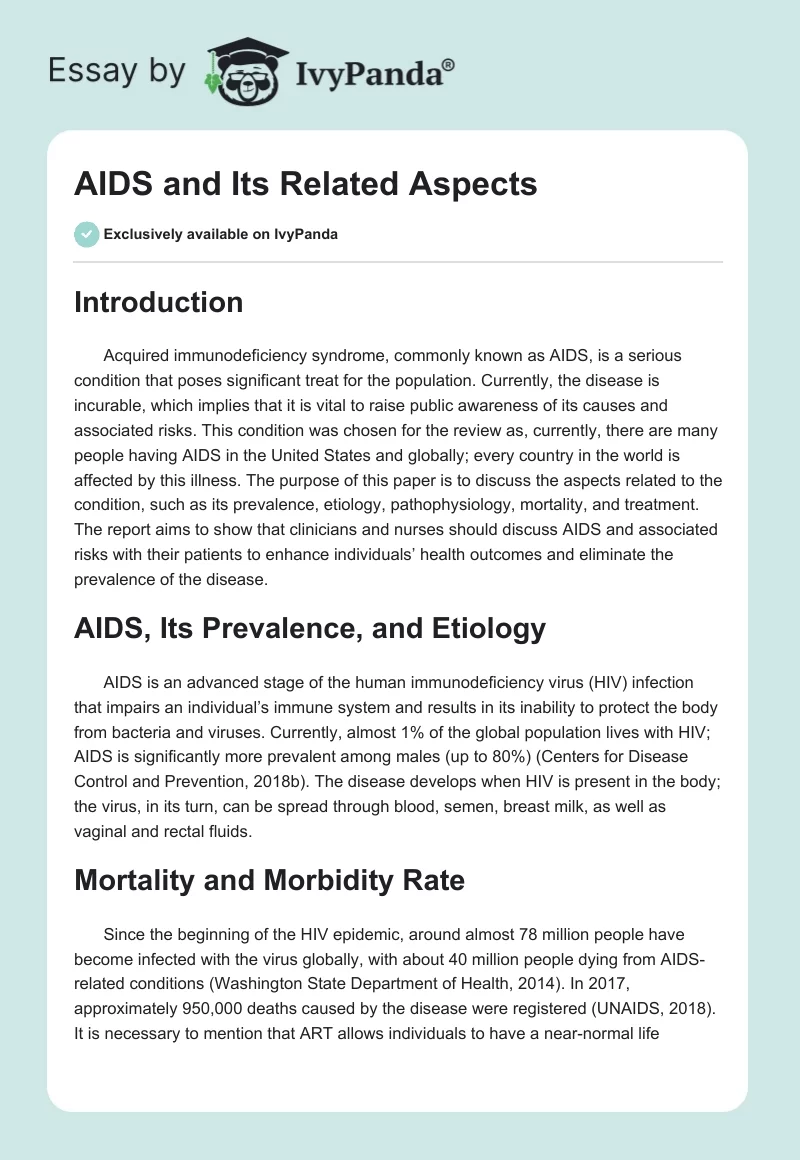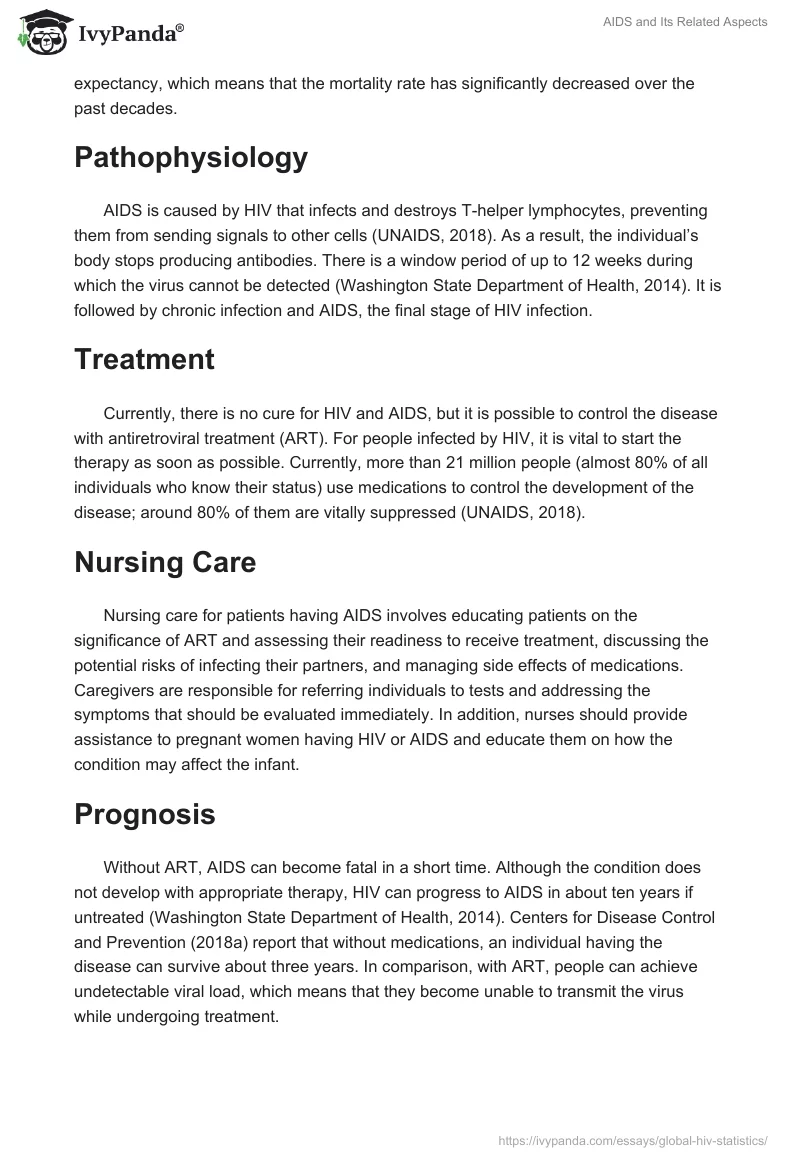Introduction
Acquired immunodeficiency syndrome, commonly known as AIDS, is a serious condition that poses significant treat for the population. Currently, the disease is incurable, which implies that it is vital to raise public awareness of its causes and associated risks. This condition was chosen for the review as, currently, there are many people having AIDS in the United States and globally; every country in the world is affected by this illness. The purpose of this paper is to discuss the aspects related to the condition, such as its prevalence, etiology, pathophysiology, mortality, and treatment. The report aims to show that clinicians and nurses should discuss AIDS and associated risks with their patients to enhance individuals’ health outcomes and eliminate the prevalence of the disease.
AIDS, Its Prevalence, and Etiology
AIDS is an advanced stage of the human immunodeficiency virus (HIV) infection that impairs an individual’s immune system and results in its inability to protect the body from bacteria and viruses. Currently, almost 1% of the global population lives with HIV; AIDS is significantly more prevalent among males (up to 80%) (Centers for Disease Control and Prevention, 2018b). The disease develops when HIV is present in the body; the virus, in its turn, can be spread through blood, semen, breast milk, as well as vaginal and rectal fluids.
Mortality and Morbidity Rate
Since the beginning of the HIV epidemic, around almost 78 million people have become infected with the virus globally, with about 40 million people dying from AIDS-related conditions (Washington State Department of Health, 2014). In 2017, approximately 950,000 deaths caused by the disease were registered (UNAIDS, 2018). It is necessary to mention that ART allows individuals to have a near-normal life expectancy, which means that the mortality rate has significantly decreased over the past decades.
Pathophysiology
AIDS is caused by HIV that infects and destroys T-helper lymphocytes, preventing them from sending signals to other cells (UNAIDS, 2018). As a result, the individual’s body stops producing antibodies. There is a window period of up to 12 weeks during which the virus cannot be detected (Washington State Department of Health, 2014). It is followed by chronic infection and AIDS, the final stage of HIV infection.
Treatment
Currently, there is no cure for HIV and AIDS, but it is possible to control the disease with antiretroviral treatment (ART). For people infected by HIV, it is vital to start the therapy as soon as possible. Currently, more than 21 million people (almost 80% of all individuals who know their status) use medications to control the development of the disease; around 80% of them are vitally suppressed (UNAIDS, 2018).
Nursing Care
Nursing care for patients having AIDS involves educating patients on the significance of ART and assessing their readiness to receive treatment, discussing the potential risks of infecting their partners, and managing side effects of medications. Caregivers are responsible for referring individuals to tests and addressing the symptoms that should be evaluated immediately. In addition, nurses should provide assistance to pregnant women having HIV or AIDS and educate them on how the condition may affect the infant.
Prognosis
Without ART, AIDS can become fatal in a short time. Although the condition does not develop with appropriate therapy, HIV can progress to AIDS in about ten years if untreated (Washington State Department of Health, 2014). Centers for Disease Control and Prevention (2018a) report that without medications, an individual having the disease can survive about three years. In comparison, with ART, people can achieve undetectable viral load, which means that they become unable to transmit the virus while undergoing treatment.
Prevention
The primary measure of preventing the development of AIDS is ART. To eliminate the risks associated with HIV, it is vital for individuals to avoid unsafe sexual behavior, use barrier contraception during all types of sexual intercourse, and avoid sharing syringes with others. In addition, it is vital to raise public awareness of the condition by educating the population on the means of its development, as well as the risks associated with HIV. Regular screening procedures available for all individuals are a crucial preventive measure too.
Current Research
Current research in the field of AIDS is concentrated on the development of medicine that will help to cure the disease, as well as the enhancement of therapies available today. Various studies evaluate the health status of individuals living with the condition, their response to treatment, and the benefits of early initiation of ART (U.S. Department of Health & Human Services, 2018). Moreover, researchers aim to identify the locations of viral reservoirs in the human body and minimize them.
Conclusion
AIDS is a severe condition and a complication of HIV infection that may develop within ten years from contamination. ART allows individuals living with the virus to prevent the development of the disease. However, it is vital to note that, currently, the illness is incurable, which means that it is crucial to enhance public awareness of the risks associated with it and promote regular screening procedures.
References
Centers for Disease Control and Prevention. (2018a). About HIV/AIDS. Web.
Centers for Disease Control and Prevention. (2018b). HIV among women. Web.
U.S. Department of Health & Human Services. (2018). HIV research activities. Web.
UNAIDS. (2018). 2017 global HIV statistics. Web.
Washington State Department of Health. (2014). Washington state HIV surveillance semiannual report. Web.


